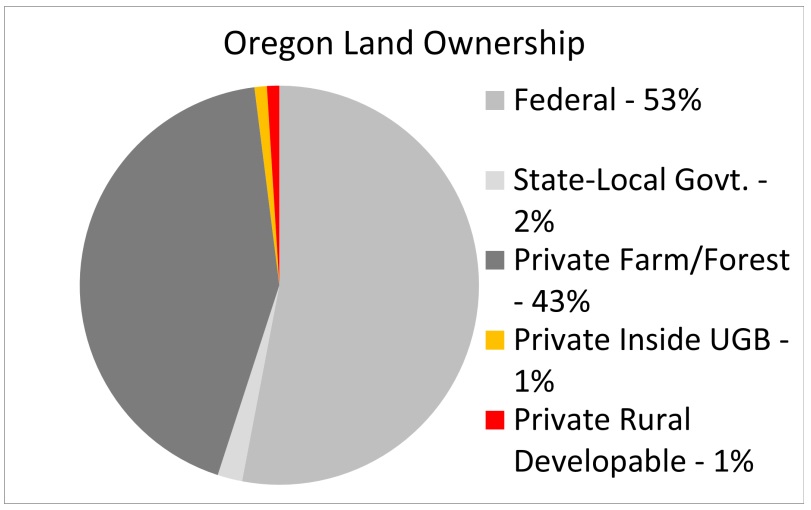
By Oregon Property Owners Association,
You don’t have to be a long-time Oregonian to have heard the most common complaint from NIMBY’s (Not in My Backyard), BANANA’s (Build Absolutely Nothing Anywhere Near Anything) and NOTE’s (Not Over There Either) when a city tries to add new areas for houses and businesses. It goes something like this:
“More affordable housing? Yeah right. This is just more sprawl from the greedy developers! We’re losing all our farmland! It won’t be long until there’s a Wal-Mart on every corner and we have no food to eat. The city has plenty of land for housing already and we don’t need any more!”
Unfortunately, this is a talking point we hear often as many are under the belief that Oregon’s farmland is in short supply. The reality is that this is statistically untrue and Oregon is actually overperforming on resource land preservation. We now have self-reported metrics from the state to help back this up.
For those in the corporate world, the term “Key Performance Indicators” should be all too familiar, but did you know that State agencies track their performance in this way too? In Oregon, each state agency is required to develop “Key Performance Metrics” (KPMs) to guide state investment in agency programs. During the budget deliberation process of each legislative session, the Legislature either approves, disapproves, or changes each agency’s proposed biennial performance measures. Each agency is also required to submit and publish a report on their KPMs, and there is usually a public hearing on their status.
This year, the Department of Land Conservation and Development (DLCD) 2022-2023 Annual Report yielded some startling results. DLCD had 14 KPMs for this biennium. According to DLCD’s report, the State has repeatedly failed to meet its KPMs for Housing Land Supply, yet is over performing on preserving Farm Land and Forest Land.
Some of you may be scratching your head right now thinking, “Wait, Oregon is over-performing at preserving farmland, but under-performing on providing enough land for housing? I thought our farms were imperiled from the risk of rampant housing development and urban sprawl?”
Based on data collected by the Department, this doesn’t appear to be the case. In fact, Oregon’s land use system appears to be overprioritizing the preservation of land for farming and logging, while cities do not have an adequate supply of residential land for building housing.
Let’s dive into the numbers over the past 5 years.
KPM #2 Housing Land Supply represents the percentage of cities that have an adequate supply of buildable residential land to meet housing needs. The biennial goal is 90 percent. For the past 5 years, the state has chronically failed to meet its goals.
- 2019 – 21% Under Goal
- 2020 – 10% Under Goal
- 2021 – 28% Under Goal
- 2022 – 23% Under Goal
- 2023 – 6% Under Goal
KPM # 13 Farm Land represents the percentage of farmland zoned for Exclusive Farm Use in 1987 that retains that zoning. This number accounts for the conversion of EFU lands resulting from expansion of urban growth boundaries and changes in zoning. The state has a goal of 90% preservation, but in 2021 and 2022 it was a 99% preservation goal.*
- 2019 – 9.8% Over Goal
- 2020 – 9.8% Over Goal
- 2021 – .76% Over Goal*
- 2022 – .75% Over Goal*
- 2023 – 9% Over Goal
KPM #14 Forest Land represents the percentage of forestland zoned for forest or mixed farm/forest use in 1987 that remains zoned for those uses. This number accounts for the conversion of forest lands resulting from expansion of urban growth boundaries and changes in zoning. Similarly, the state has a goal of 90% preservation, but in 2021 and 2022 it was a 99% preservation goal.*
- 2019 – 9.9% Over Goal
- 2020 – 9.9% Over Goal
- 2021 – .9% Over Goal*
- 2022 – .1% Over Goal*
- 2023 – 9.91% Over Goal
A Uniquely Broken System.
While Oregon’s land use planning system is certainly one of a kind, it is not above reproach. Like any other system of government, its susceptible to bureaucratic failures, misalignment of priorities, and abuse. Today, it seems like Oregon’s planning system has simply lost the plot. This system was supposed to support orderly and responsible growth, not prevent communities from achieving needed development. It was supposed to protect agricultural lands to support the agricultural economy, but not preserve all rural lands for open space in perpetuity.
Everyone knows that we are in a housing affordability crisis. For some, this seems like an abstract issue caused my mystic market factors out of our control. The truth is that while there are several reasons explaining how we got into this mess, many of its causes and solutions are very much within the control of the Legislature and our state agencies, specifically DLCD. It matters what the state’s priorities are and how they are implementing our land use system, as that regulates how and where development can occur. Moreover, you, the taxpayer, are responsible for funding its performance, or lack thereof.
According to the most recent data supplied by DLCD, of the approx. 63,000,000 total acres in Oregon, only about 395,320 acres are zoned for residential use inside UGBs. This means that slightly more than half of one percent of Oregon’s land is available to house nearly all Oregon families. This stands in stark contrast to the approximately 16.1 million acres zoned for exclusive farm use. That’s about 26% of all lands, and more than half of the privately owned land in the state.
In sum, there’s a lot of land being held aside for farming and ranching, and a very tiny amount of land available to house most of our population. The result? Extremely high land prices, chronic underproduction of housing, rising levels of homelessness, and severely cost-burdened families. It also means that a very small percentage of people own a majority of the land in the state, leaving most of our population to spend their wages of rent, instead of building equity in home ownership.
As we celebrate 50-years of our planning system, we should be asking the hard questions. Is this system really working how it was intended? And even if it is, do we really want these outcomes?
OPOA Leads the Charge for Change.
The Oregon Property Owners Association will be working with fellow housing advocates to try and bring balance back to the system and improve DLCD’s implementation of the land use system to promote housing development. If we were able to increase the amount of land available for housing and reduce other regulatory barriers to affordable housing production, we could drastically increase the number of homes available for families to own in the immediate future.
In the short term, we will be asking for significant changes to DLCD’s KPMs to align the Department’s work with the needs of Oregon communities. If changes are made to the KPMs, we would see those in the Agency Requested Budget for 2025-2027 next summer.
We support a thriving agricultural and timber economy, and no one in interested in turning Oregon into California, but we need to be able to house Oregonians at affordable prices. Having enough buildable land for housing is an essential piece of this puzzle. DLCD’s priorities and performance metrics must reflect this reality.
Disclaimer: Articles featured on Oregon Report are the creation, responsibility and opinion of the authoring individual or organization which is featured at the top of every article.


